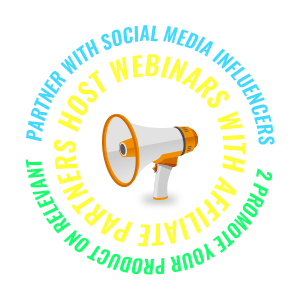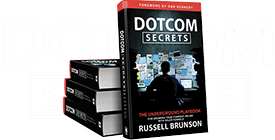You have a great product.
But how should you introduce it to the market?
Today we are going to discuss three ways to do that.
We will also share the #1 launch mistake that you must avoid at all costs.
So are you ready to put your product in front of your dream customers?
Continue reading…
- #1: Partner With Social Media Influencers
- #2: Promote Your Product on Relevant Podcasts
- #3: Host Webinars With Affiliate Partners
- The #1 Launch Mistake That You Must Avoid at All Costs
- The Value Ladder Sales Funnel: The Most Effective Way to Sell Online
- Want Russell to Teach You How to Build Your First Sales Funnel?
#1: Partner With Social Media Influencers
Did you know that the influencer marketing industry has been growing steadily for the last five years?
In 2021 the industry is projected to reach a market size of $13.8 billion. That’s an astonishing 42% growth since last year!

Influencer Marketing Hub team has conducted a survey of over 5,000 people for their “The State of Influencer Marketing 2021: Benchmark Report”. What did they learn?
Apparently, not only 90% of respondents believed that influencer marketing was effective but 62% of them also intended to increase their influencer marketing spend.

Interestingly, 72% of respondents believed that influencer marketing campaigns brought in better quality customers compared to other marketing methods.

It’s clear that influencer marketing is:
- Increasingly popular
- Extremely effective
- Here to stay
So how can you use it to launch your product?
A: Pick the Right Platform
You should start by picking the best platform to reach your dream customers. Where do they hang out online?
As our co-founder Russell Brunson writes in his book “Traffic Secrets” (get it for free here):
“When you have a perfect vision of who your dream customer is, it becomes easy to find where they are congregating. On the contrary, if you don’t have perfect clarity on who that person is, it’s really hard to find them.”
So if you are struggling to identify the right platform, you might want to take a step back and get more clarity on who your dream customers are.
That being said, when it comes to influencer marketing, the platform question largely boils down to…
Instagram vs. Tiktok
Instagram is the most popular platform for influencer marketing.
It’s where the beautiful, the famous, and the rich go to show off their amazing lives and where the rest of us go to live vicariously through them.
So if you are at a loss as to which platform you should use, Instagram is probably the safest bet.
However, while TikTok is still the runner-up, it’s closing in quickly and coming for Instagram’s crown.
You might want to consider that platform for your influencer marketing campaigns as well.

Other Platforms
Here’s the list of the six most popular platforms that you should consider:

You might want to use Statista to learn more about each platform so that you could make a more informed decision:
It will help you better understand where you will have the best shot at reaching your dream customers.
B: Partner With Influencers for Your Product Launch
Once you have chosen a platform, it’s time to partner with influencers in your niche.
Here’s how Upfluence defines various types of influencers based on their following sizes:
- Micro-influencer: less than 15,000 followers
- Regular-influencer: between 15,000 and 50,000 followers
- Rising-influencer: between 50,000 and 100,000 followers
- Mid-influencer: between 100,000 and 500,000 followers
- Macro-influencer: between 500,000 and 1,000,000 followers
- Mega-influencer: more than 1,000,000 followers
Interestingly, micro-influencers seem to have the highest engagement rates on Instagram, YouTube, and TikTok.
Consider partnering with those with <15k followers in your niche.
They are likely to:
- Be more affordable
- Be easier to negotiate a deal with
- Have closer relationships with their audiences
Of course, the larger the influencer’s following, the more exposure for your product, so if your budget allows it don’t hesitate to team up with people that are higher up on the influence hierarchy.

Speaking of your budget…
You might be surprised to learn that free product samples are still the most common type of influencer payment.
However, offering cash will make the influencer feel more valued, which might pay off in the long run.

C: Build Long-Term Relationships With Influencers
You should go into influencer marketing with the big picture in mind:
It’s not just about your launch, it’s about building a sustainable business.
So approach your partnerships with influencers from that perspective.
Treat them well, ask them for their ideas and pay attention to their advice, and compensate them generously for their work.
You want to build long-term relationships with influencers so that you could work with them for years to come if the initial collaborations prove to be a success.

Warning: Protect Your Brand Image!
One thing that you need to keep in mind when it comes to influencer marketing is that the behavior of the people you decide to partner with will affect the public’s perception of your brand.
It’s best to avoid influencers who seem unstable, are constantly engaged in e-drama, or are outspoken on controversial issues (unless your brand has the same stance on those issues).

#2: Promote Your Product on Relevant Podcasts
Edison Research has conducted a survey of 1507 Americans aged 12+ for their “The Infinite Dial 2021” report.
According to their data, podcast listening has been growing in popularity for the last four years, so we can probably assume that this trend is going to continue in the foreseeable future.

Moreover, while podcasts are the most popular among the 12-34 age group, the age group of 35-54 are not that far behind.

It’s also worth noting that both men and women enjoy listening to podcasts more or less equally:

All that means that podcasts can be a great way to reach your dream customers if they are younger than 54 years old.
Here’s how you can do that:
- Identify the most relevant podcasts in your niche – Don’t hesitate to advertise on smaller, more niche podcasts (e.g. a podcast about SEO as opposed to a podcast about online marketing in general).
- Reach out to podcast hosts and build partnerships – Free product samples won’t fly here. Research the going rates for podcast ads in your niche. You should be prepared to pay that.
- Build long-term relationships with podcast hosts – Same as with influencer marketing, you want to approach podcast advertising with the big picture in mind and build lasting relationships.
#3: Host Webinars With Affiliate Partners
Webinar marketing can be a great way to introduce a new product to the market because it not only allows you to tap into the audiences of other people but also helps you build your own email list.
In fact, it was the primary strategy that our co-founder Russell Brunson used to take ClickFunnels from zero to $10 million in annual revenue in just one year (learn his webinar secrets here).
Here’s how it works:
- You create a webinar funnel
- You find an affiliate partner
- You and your affiliate partner promote the upcoming webinar
- You host the webinar
- You and your affiliate partner split the revenue generated from that webinar

Secrets to Growing Your Business With Webinars
Want webinar marketing to work for your business?
You need to do these three things:
- Partner with the right people – Is their target audience the same as your target audience?
- Provide a ton of free value – A person who decided not to buy your product should still walk away having benefited from attending your webinar.
- Have a clear call to action – What do you want the attendees to do next? You need to make that clear.
The call to action is what people struggle with the most because the transition from the free value to the sales pitch can feel awkward.
Here’s a script that you can use to make it seamless:
“So now I’d like to offer you guys something that I’m really excited about. It’s something that I think is going to change tons of lives and businesses for the better. But I don’t want to do it without your permission. If you guys want to learn more about [PRODUCT/SERVICE] then just type “Yes” in the chat bar.”
And what if you don’t get any yeses?
Then say this:
“Okay. Well I don’t want to take up too much of your time. But I really think this is going to be a game-changer for you. Is it okay if I just spend 10 minutes showing you this offer I put together?”
Now, it’s possible that the attendees won’t be okay with that, but it’s so unlikely that there’s no point in worrying about it (and you’d survive anyway).
Generally, people don’t stick around if they decide that your webinar is garbage, so the ones who have made it to the call to action will likely be interested in hearing about your offer.
The #1 Launch Mistake That You Must Avoid at All Costs
Would you ask someone to marry you on the first date?
- That person might be perfect for you
- They might be the love of your life
- You might end up marrying them eventually
…but if you propose on the first date, they are going to say no. This seems incredibly obvious, right?
Yet entrepreneurs make the business equivalent of this mistake all the time!
Here’s What You Need to Understand:
- Your dream customers don’t know who you are (yet)
- Your dream customers have no reason to trust you (yet)
- Your dream customers are not going to hand you their hard-earned cash the moment they hear your offer
So why would you immediately ask them to buy your product?
Here’s what you should do instead…
The Value Ladder Sales Funnel: The Most Effective Way to Sell Online
Russell has developed a sales funnel called the Value Ladder.
Here’s how it looks like:

You only need to focus on the first two stages for your product launch:
- Create a lead magnet
- Create a landing page for that lead magnet
- Drive traffic to that landing page
…and only then pitch your product to people who gave you their email addresses.
For Example:
- Want to use influencer marketing? Get influencers to promote your lead magnet instead of your product.
- Want to use podcast advertising? Use it to promote your lead magnet instead of your product.
- Want to use webinar marketing? Then your webinar is your lead magnet. You and your affiliate partner should drive traffic to the registration page.
So you start the relationship with that dream customer by providing free value first.
And then, once you have their email address, you can continue building that relationship by providing more free value as well as offering paid value.
You can learn more about the Value Ladder sales funnel in this video where Russell explains the main idea behind it:
Want Russell to Teach You How to Build Your First Sales Funnel?
Let’s keep it real:
Building a sales funnel from scratch can seem like a daunting task.
That’s why we have created our 5 Day Challenge where Russell walks you through it step-by-step.
You will learn how to:
- Generate unlimited leads
- Create your first lead magnet
- Build your first sales funnel
- Create a simple 6-email follow-up sequence
- And launch your funnel!
…in just five days.
So don’t hesitate.



One of the best articles I have ever read about a product launchst Thanks for sharing it us
Great and Informative article . Please share more articles
Happy to be of service. Hope we help you along your journey.